#botanical metropolis
Explore tagged Tumblr posts
Text
Exploring the Enchanting Holiday Train Show at the New York Botanical Garden
Exploring a Botanical Metropolis: New York’s Holiday Train Show Good morning. It’s Monday, and today we’re set to embark on a magical journey through a city within a city—an enchanting landscape constructed from acorns, tree bark, and a variety of plant materials. Additionally, we’ll delve into the State Department of Labor’s investigation into Shen Yun Performing Arts. What we’re about to…
#botanical metropolis#freight trains#holiday train show#iconic buildings#Jennifer Bernstein#miniature city#natural elements#New York Botanical Garden#passenger trains
0 notes
Text

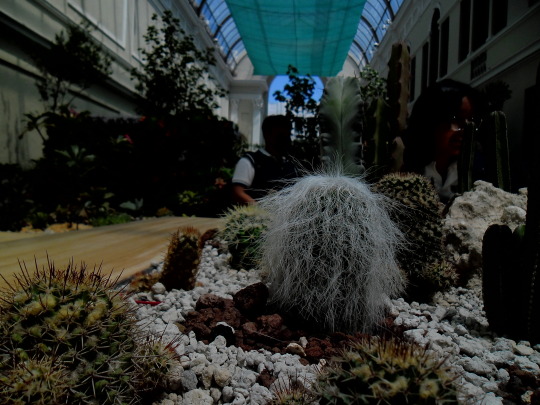


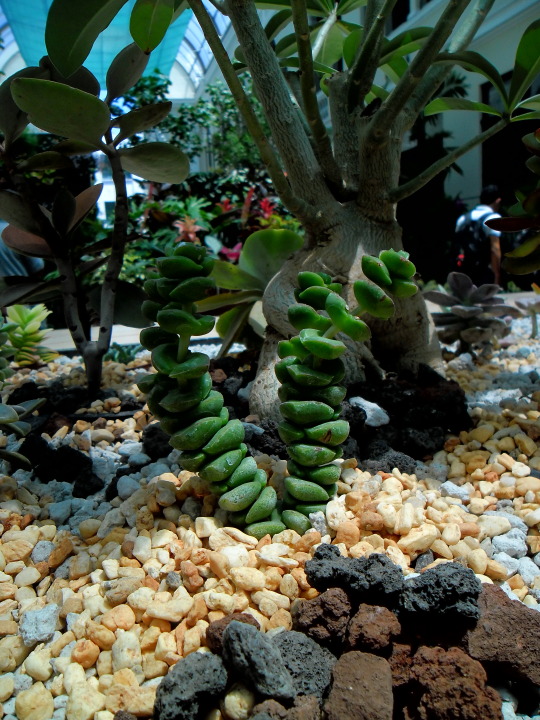


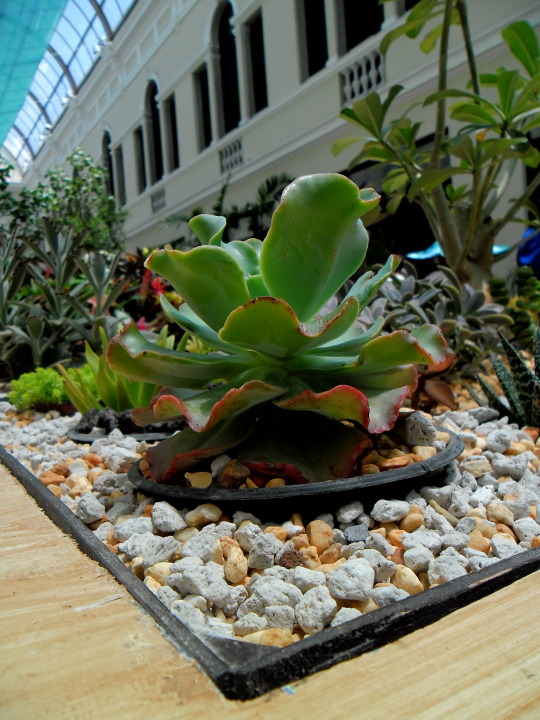

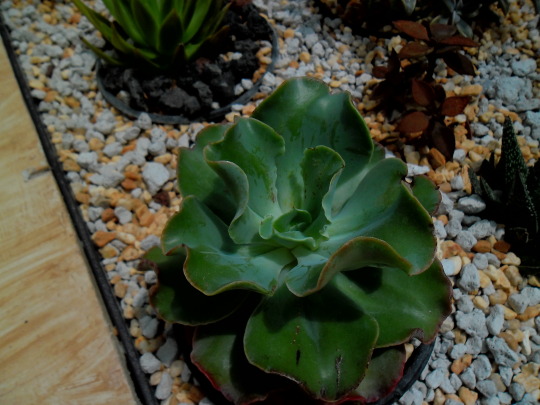
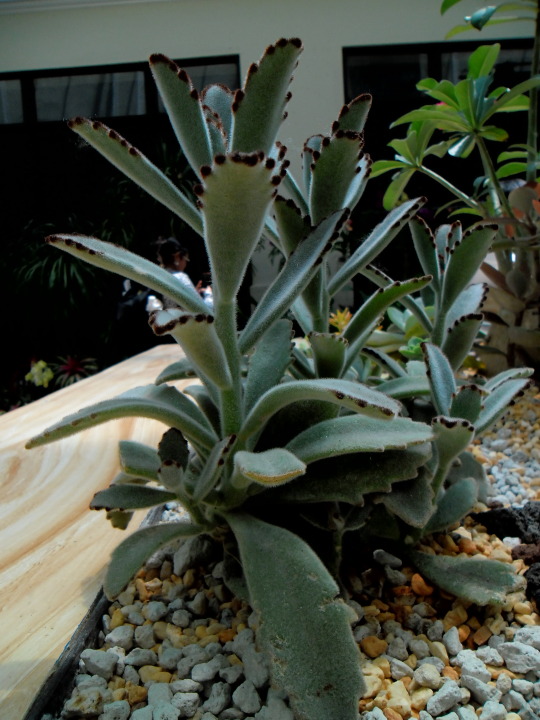
#streetphotography#street#photography#photogram#photographers_of_mexico#merida#yucatan#yucatanmexico#ciudaddemeridayucatan#fotografiaurbana#fotografiacallejera#fotografianocturna#urban#metropolis#calles#mexico#photostreet#meridayucatan#yucatán#streetphoto color#street photography#desert plants#plantas de desierto#plantas#botanic garden#flores#primavera
1 note
·
View note
Text
Calorum Lore Shared in the Dropout Discord
Thank you, Past!Brennan.
Some of them might re-contextualize a thing or two about TRW series. Typically in response to specific questions, but I focused solely on posting Brennan's responses.
Lore on The Ravening War (from April 20, 2020 1:02am ET)
In 1188, a conflict broke out because Count Jacques Tomaté, a Fructeran noble, was by birthright next in line for the throne of Greenhold!
Culture of the Meat Lands (Feb 21, 2020)
Brennan: Meatlanders have clan delineations based on bloodline and their worship/propitiation of The Great Beasts, which is a pagan, polytheistic faith! Warfare between various clans goes back centuries and centuries, a lot like the ancient Celts, so while some Meatlanders might feel kinship with other Meatlanders over outsiders, it's just as common for a given Meatlander to feel THE MOST animosity to a member of an enemy meat clan. So "The Meatlands" doesn't really have a national identity in the same way that, say, Ceresia does, and individuals there are much more likely to define their loyalty by family, clan and faith than by nationality.
(May 18, 2020 8:14pm ET)
The Meatlanders are like ancient Celts: The fact that they don't wear shirts lets southerners stereotype them as barbarians, but their culture is equally as beautiful, ancient and complex as any other land's. Carn is a metropolis full of architectural wonders, beautiful art, etc. Meatlanders rule!!! Labeling them barbarians, like in real life, is a tool artistocrats use to breed xenophobia and hatred into their homleands population, making them more malleable and compliant
The Rocks Sisters (May 1, 2020 11:46pm)
The four sisters were the four archetypal classes! Fighter, Wizard, Cleric, Rogue!
Magic Items (April 20, 2020 9:44pm ET)
Magical items aren't quite as prevalent in other nations as they are in Candia!
Amethar's Mom (April 20, 2020 1:21am ET)
Amethar's mother, before she was Queen Pamelia Rocks, was Pamelia Pomegrana, a Fructeran noble!
Magic and Miracle Workers (from April 20, 2020 1:04am, 1:06am, 1:15am)
Brennan: Just like in normal D&D, it takes SPECIFIC training or divinatory magic to tell if magic is arcane or divine, or where its power source originates from! People's reactions to magic are LARGELY based on uninformed prejudice, and aesthetic. This is how Lapin is mostly able to con people.
Even within the Bulbian Church, 99+% of its clergy CAN'T cast magic. Being a miracle worker is a REALLY big fucking deal, and almost always guarantees ROCKETING to the top of the church hierarchy
Liam's magic truly getting him in trouble depends on context! Obvious spellcasting would get him in a lot of trouble, but Candian's magic items usually get a pass from commonfolk because it would be viewed as "alchemy," which isn't seen as being heretical at all!
Leadership in Calorum (from May 6, 2020)
5:32pm ET
Brennan: Plumbeline is the Sovereign Ruler of Fructera, yes! Gustavo had to abdicate in order to become Concordant Emperor! Plumbeline's title is still Lady though, Fructera doesn't have a monarchy, it has a complex consortium of Noble Houses that rule through an orchestrated bloc of alliances, kind of an aristocratic bureaucracy!
5:40pm ET
Brennan: Dairy Islands ALSO a monarchy, just doesn't confer the title of King or Queen to its monarch (uses Prince or Princess), also Ceresia HAS been a monarchy at times, has vacillated between Republic and Imperatorship MANY times, with some dynasties of Imperators lasting a dozen generations or more!
Social Categories
Brennan: All the food nations have weird edge cases, so the delineations are DEFINITELY social and not biological/botanical. Pie people, a combination of grain, butter and fruit, are overwhelmingly Candian. In Calorum, these edge cases would be much like they are in our world, the result of historical wars of conquest, marriages, alliances, etc!
Genetic Complexity (from April 20, 2020 2:14pm ET)
Brennan: Popping in here like a goddamned troll to say that Calorans' DNA are powerfully influenced by more than just their parents genetics, but also by the geographical location of their conception, their gestation and even their childhood dwelling place up through puberty! I suspect that every question I answer only serves to raise further questions, for which I am deeply sorry!!
Other Monarchies in Calorum (May 6, 2020 5:40pm ET)
Brennan: Dairy Islands ALSO a monarchy, just doesn't confer the title of King or Queen to its monarch (uses Prince or Princess), also Ceresia HAS been a monarchy at times, has vacillated between Republic and Imperatorship MANY times, with some dynasties of Imperators lasting a dozen generations or more!
Queer Rights in Calorum (from May 18, 2020 8:23pm)
Brennan: Candia is the MOST permissive of all the nations in terms of most issues, but no nation in Calorum is openly homophobic. However, it's important to remember that archaic concepts like bloodlines, political marriage, heirs and primogentiure [sic], etc. still exist in this world, and are more emphasized and expected in nations outside of Candia, which puts a lot of pressure on the nobility from that end of the spectrum. In a weird way, that means peasants are a lot freer in terms of who and how they love and marry than aristocrats and especially royals, which there is also some interesting IRL research and precedent for!
Post-War Events (May 18, 2020 8:07pm ET)
I don't think any of these are spoilers, but Amethar and Caramelinda married shortly after the war ended. King Jadain died shortly after the war, after the establishment of the Concord!
Funeral Rites of Calorum's Faiths (May 18, 2020 8:04pm ET)
Bulbians practice burial and very formal funereal rites, and have a sharp delineation between body and spirit, so the body which is crass and material goes back into the ground, and the soul joins the Bulb. Meatlanders practice cremation, and have different beliefs based on religious affiliation, but most Great Beast faiths belief that an afterlife is EARNED through great deeds, otherwise you're reincarnated and get to try again!
217 notes
·
View notes
Text
東京都
Japanese Prefectures: Kantō - Tokyo
都道府県 (とどうふけん) - Prefectures of Japan
Learning the kanji and a little bit about each of Japan’s 47 prefectures!
Kanji・漢字
東 ひがし、トウ east
京 キョウ、ケイ capital; 10**16 (ten quadrillion)
都 みやこ、ト、ツ metropolis, capital
関東 かんとう Kanto, region consisting of Tokyo and surrounding prefectures
The capital of Japan, Tokyo has 23 special wards (東京都区部), 26 cities, 1 district (西多摩郡), and 4 subprefectures (支庁)

Tokyo is the largest urban and industrial agglomeration of Japan. Since ancient times the unassuming fishing village of Edo existed for centuries before the Tokugawa shogunate (1603-1867) made it into the capital city, while the imperial family remained in Kyoto. The Tokugawa shogunate ended with the Meiji Restoration of 1868, and Edo became the official capital of Japan, renamed to Tokyo, meaning "eastern capital." It was already the largest city in Japan and the population exceeded one million. Now it is one of the world's most populous cities and the largest industrial, commercial, and financial center in Japan. The Imperial Palace, the home of the emperor of Japan, lies at the heart of the city, encircled by stone-walled moats and broad gardens. Tokyo is the chief transportation hub for Japan and an important international traffic center, and also Japan's major cultural center.
Recommended Tourist Spot・おすすめ観光スポット Shinjuku Gyoen National Garden - 新宿御苑

Shinjuku Gyoen National Garden
When it comes to Tokyo there is an endless list of things to do and see. So picking one to highlight was difficult, but I went with a favorite of mine. Located a short walk from Shinjuku Station, spacious lawns, meandering walking paths and tranquil scenery of Shinjuku Gyoen provide a relaxing escape from the busy urban center around it. In the spring, Shinjuku Gyoen becomes one of the best places in the city to see cherry blossoms, and in the fall the autumn colors are stunning. With an admission fee of only ¥500, it is a wonderful way to get lost in the beauty of an oasis in the middle of the metropolis.
Shinjuku Gyoen, meaning Shinjuku Imperial Garden, originated during the Edo Period (1603-1868) as a feudal lord's Tokyo residence. Later, it was converted into a botanical garden before being transferred to the Imperial Family in 1903 who used it for recreation and for the entertainment of guests. The park was almost completely destroyed during World War II, but was eventually rebuilt and reopened in 1949 as a public park.
There are three main gardens - the Japanese garden, the French garden, and the English garden - as well as a greenhouse full of tropical flowers. There are restaurants and cafes, a tea room, and a rest house with souvenirs. The garden is so large that I have never been able to view it all in one visit.
Regional Cuisine - 郷土料理 Monjayaki - もんじゃ焼き

Monjayaki (source)
A type of pan-fried batter or savoury pancake, monjayaki is Tokyo’s version of okonomiyaki, the iconic dish of Hiroshima and Osaka. Monjayaki looks less like a potato pancake than okonomiyaki and retains a slightly runny appearance similar to melted cheese, even when cooked, but the cooking method remains the same.
The origins of monjayaki or monja can be traced back to a crêpe-like confection known as mojiyaki in the late Edo period. It was called mojiyaki (moji means character, as in hiragana) because people used it to write characters on the hot griddle surface. Monja experienced a popularity boom in the 1980s that led to the birth of Monja Street on Nishinakadori in Tsukishima where today 75 monja restaurants line the street.
To cook monja, first, stir-fry the ingredients, consisting of meats, veggies, cheese, and mochi or crispy noodles – on the griddle. Once they’re almost cooked, form a doughnut shape with a hole in the middle and pour the batter into it. Wait until the batter starts to boil, then mix it all up and press it down with the spatula to better cook it. Then scoop it into a bowl or onto a plate and enjoy.
Tokyo Dialect・Toukyou no hougen・東京の方言
Generally, the Tokyo dialect is taken to be Standard Japanese, although slang can vary between regions and social classes. Traditional dialects in central Tokyo are generally classified in two groups: Yamanote dialect (山の手言葉, Yamanote kotoba) and Shitamachi dialect (下町言葉, Shitamachi kotoba). The Yamanote dialect is characteristic of the old upper class from the Yamanote area. Since the Meiji period, Standard Japanese has been based on the Yamanote dialect. The Shitamachi dialect is a working-class dialect, and it preserves features of Edo Chōnin (Edokko) speech, also called Edo dialect (江戸言葉, 江戸弁, Edo kotoba, Edo-ben). Tokyo-style rakugo is typically played in the Shitamachi dialect.
Tokyo dialect dates back to Tokugawa Ieyasu's establishment of Edo as the main capital. Large groups of people, speaking a range of dialects migrated across the country from the former capital of Kyoto. The Kyoto dialect was the prestige language of the time and strongly influenced the Edo dialect in the early Edo period. The Edo dialect grew as Edo became the largest city in Japan and became the new prestige language in the late Edo period. Because of its unique history, especially in relation to the Kyoto dialect, Tokyo is what is known as a language island in the Kantō region. For example, traditional Kantō dialects have been characterized by the use of volitional and presumptive suffix -be, which is rarely used in Tokyo.
あたぼー (atabou)
Standard Japanese: 当たり前 (atari mae) English: obviously
あんまり (anmari)
Standard Japanese: あまり (amari) English: not very much
しょっぱい (shoppai)
Standard Japanese: 塩辛い (shiokarai) English: salty
でかい (dekai)
Standard Japanese: 大きい (ookii) English: big
About Tokyo dialect (Japanese page)
#japanese prefectures#日本語#japanese#japanese language#japanese langblr#langblr#studyblr#都道府県#東京都#tokyo
26 notes
·
View notes
Note
YOU. Kicks my legs like we're at a sleepover. Who was the character u were posting about in the tags.. spill..
kicking my legs back, ready to paint your nails at any time soooooo
okay i already dedicated a whole 2k word post to his partner goddess weird animal who bites him sometimes personal jester friend (?) Ysmé, so this time I'm going to spill about Loïc Ard from Soul of Sovereignty (prelude), an hour-long adult fantasy visual novel preview (< link here) that arrived on itch late last year courtesy of webcomic artist GGDG (if you're familiar with Lady of the Shard or CQ, you know their work)
So. This idiot.
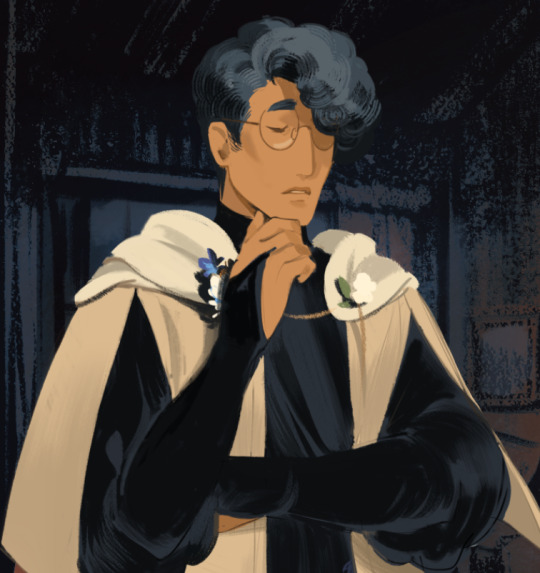
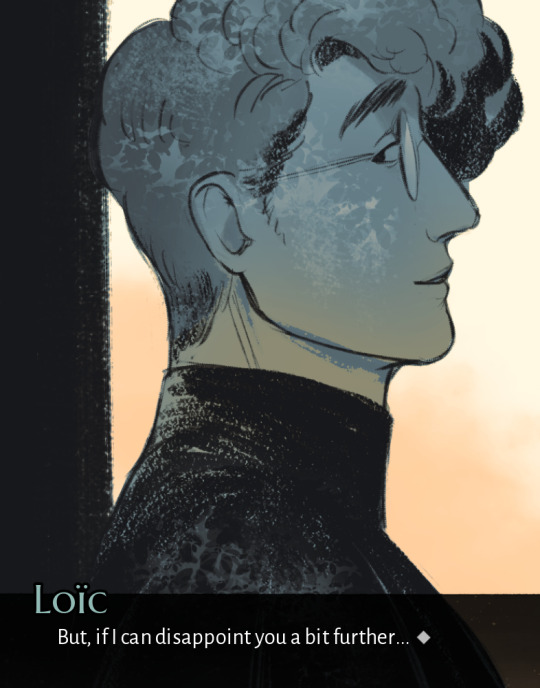
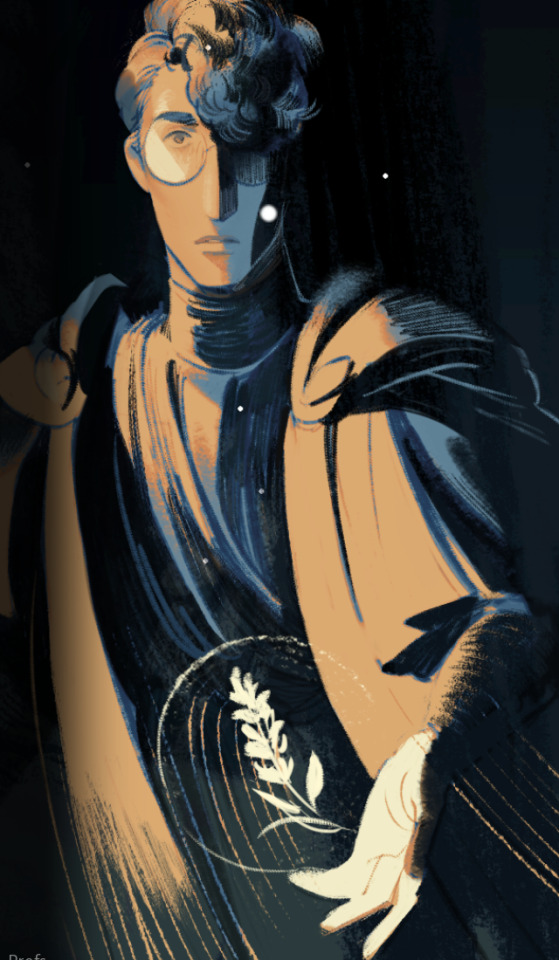
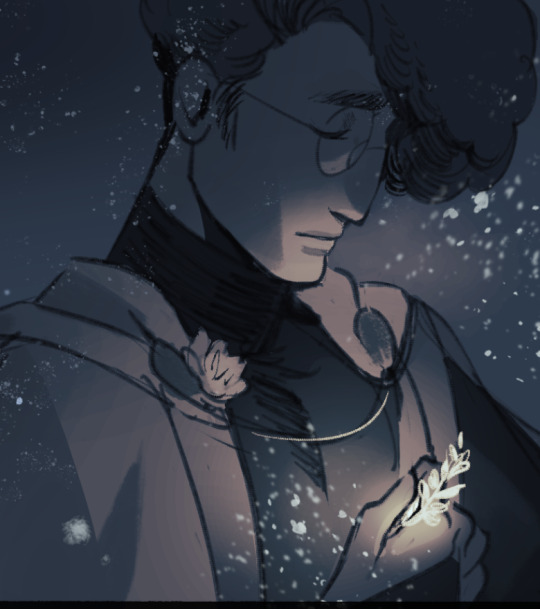
look at this character design. the people hunger for men with strong cheekbones and glasses. look at the robes that attach at the fucking fingertips to draw attention to the position of his hands.
He's very soft-spoken and sweet. He knows a lot about the history of his world, as well as the biology of what lives there. He's staggeringly generous to others, even complete strangers. He's good at cooking. He knows how to sing.
He's the viewpoint character for the lion's share of the story atm, we get to look into his brain a little more often than Ysmé's for reasons that Will Become Rapidly Apparent As You Play.
Loïc is a middle-aged guy (late 30s? early 40s?) who works in an unofficial capacity at an inn in bugfuck nowhere (Tarn, a northerly village miles from anywhere else and regularly frozen solid by blizzards, with a population of Not Enough To Maintain Infrastructure), helping to cook, clean, and care for its mostly non-paying clientele, who his friend Alma, the proprietress, is allowing to stay for free. It's become a glorified sickhouse and shelter. No one is paying to stay in Tarn, but Alma can't turn her back on what she considers her hometown and Loïc can't turn his back on Alma (and he's here for other reasons too) so the inn is just kind of slowly decaying as conditions get less and less profitable. This sucks.
Especially because Tarn was built less than a century ago as an adventurers' hub for treasure hunting squads looking to uncover temples and relics right nearby, and the inn used to be full of good people and good food and fire and light and Alma wants all that back so bad it hurts and she refuses to say it's cooked and move back to the big city (in this case, the Mosaic, an ark-like vertical metropolis that housed humanity for hundreds of years after their world's apocalypse. After the outside was deemed safe again a century back, many people wanted to try and make a living documenting and salvaging stuff... but most of it turned out to be decayed, empty, and/or worthless, after so much time had passed.) The Mosaic is bright and lively, but it's a restrictive place to live for a lot of people-- cultures outside the dominant (very fantasy-Catholic) one are suppressed and the focus on making money to survive is exhausting.
But Loïc makes things a little less miserable. He's got a calm and pleasant bearing, he brightens up the place with flowers and greenery he manages to get growing even in this climate (he's a florist), and he's someone to talk to. He's witty, he's thoughtful, and he's almost a little too willing to dedicate all of his time and energy to helping people, and overall he's this mundane nice fella... with one big caveat you learn real early on.
Loïc is a mage, and a really unique sort.
The floristry bit isn't just his job or a characterization quirk, it's the whole basis of his magic. Species of flowers in this world each hold a unique concept-- fire (pallisia), calm (lavender), light (white dawn's eye), mundanity (dandelion), memory (cloud sage), you name it, there's probably some obscure botanical species that represents something in the ballpark of it. A god of language (Fayim) allegedly imbued a meaning into each, and if you can commune and reflect and experiment around hard enough to unravel the concept of one, you can turn that concept into something real.
Think of it like magical linguistics -- [correct flower] + [expressed meaning] = [physical effect], like [correct phonetics] + [contextual meaning] = [language]. You can even chain a couple of them to make a more complex spell, like turning words into compounds, phrases, and sentences, but you do have to understand what it actually means to do so. You're forming a connection to Fayim's power by talking. This burns up the flower, but Loïc's extreme dedication to botany means that he's got a regular supply of the spells he uses most often.
Loïc can hand you a golden pallisia blossom, start waxing poetic about the nature of warmth, and the firelight kept inside will radiate out and keep you comfortable even in Tarn's frigid weather. It's rare and potent stuff, doubly so because worship of Fayim is dwindling-to-nonexistent in the Mosaic, where the only faith and magic most people are familiar with at all are those revering the Builder, the creator deity who erected the Mosaic and saved humanity from the apocalypse in the first place. Everything else? False gods. Loïc himself doesn't worship Fayim or the Builder; he uses Fayimic magic but is pretty disconnected from his own background + faith in general. He's interested in the theology but doesn't use prayers in his invocation if he can help it.
Magic's not foreign to this world (most people in this world know at least a little artisanry, a more logical and physical approach to magic which lets you stitch together bespoke objects out of thin air, used heavily in both art and industry), but flower reading is a rare and dying language. Loïc's cute little flower shop back in the Mosaic was also a spell broker for people in need of small miracles. Given that the Mosaic worships a creator deity, I guess this implies that magic, generally, is something humans tap into extant divinity to borrow.
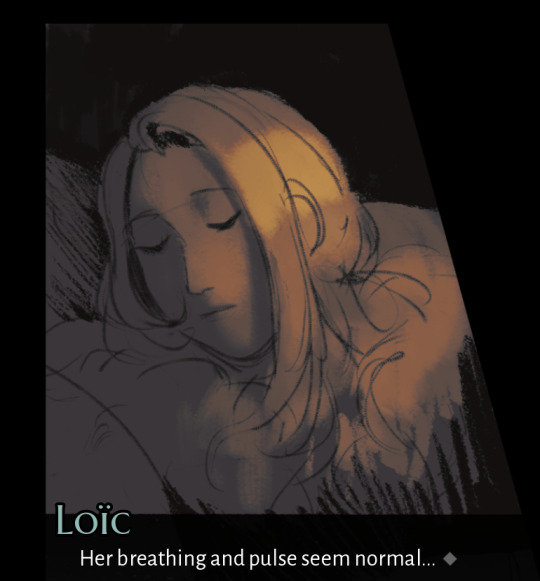
So, Loïc is holed up in Tarn studying magic and using mending spells (yellow rose) to cure people of minor injuries, but everything goes to hell when a certain sickly blonde washes up at the inn's doorstep begging for help escorting her to a nearby temple please please you gotta, she'll die from turbo tuberculosis otherwise, god (not the builder, some other guy, don't ask who) said so. Oh my gosh, you will? Thank you so muchhhhhh
[paraphrased very hard]
alma: this is definitely a scam of some kind. please just talk her out of this so she doesn't get eaten by mutant wolves.
loïc: oh for sure but you don't try for scam this obvious unless you're really desperate. idk what she even wants here, let me feel her out. i have nothing worth robbing. maybe this is a trauma thing or a money thing and i can talk to her about it.
alma: loïc, that's literally not your problem. loïc there's this weird pattern where you prioritize the hypothetical wants of strangers over your own proven needs. loïc no.
loïc: loïc yes
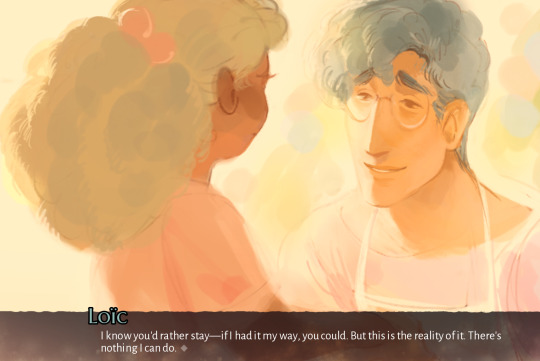
So, of course, it ends up coming out that Loïc is in Tarn specifically because he is a single father with a daughter named Lelia who is comatose from an unspecified illness. Her prognosis is extremely grim (low chance of survival that dwindles the longer she stays out, probably terminal.)
Specifically, he's on a hopeless little snipe hunt for a rumored species (the glass bell) that could act as a panacea for any illness, if harnessed correctly in a spell, and it might either be extinct or entirely fictitious.
He knows he can't find it alone. If it even exists, it is a needle in an impossibly massive haystack. He is consumed inside-out with a compulsive need to do something about it, and when that proves impossible, it starts spreading into a compulsive need to do something for anyone. The grief of admitting that Lia is already in a prolonged state of death would eat him alive, so if he can transfer that feeling of purpose onto anything else he can buoy himself. He is spinning his wheels because confronting the fact that he has outlived his own daughter and has to go on without her is impossible.
But like... he's dying slowly, too, in this state. Like Lia. Like Tarn. It's only a matter of time before there's nothing left of himself to give, and at the impetus of the story that's basically what he wants. There's nothing left for him.
... Unless...!!
OTHER THINGS:
would give blessings to his daughter every day before she went to school
apparently has a puppy and a kitty back home
loves lavender and sunflowers most
sometimes casts so hard he passes out
including other people and making his casting into a conversation is a quirk he does and that's just super cute
carries pictures of his daughter around in his spellbook maes hughes style
besides his suspiciously alb-and-chasuble looking mage robes, wears an apron and skirt around the house + gg regularly draws him in cute dresses. this is a known victor's weakness.
the in-game glossary has botany notes from him, usually paired with him waxing poetic about each species' meaning. this nerd shit is a known victor's weakness.
you see his general bearing and a lot of people assume he's kind of this easily-flustered anxious disaster type, but he's actually very serene and difficult to get a rise out of. he'll play along with most jokes you try to throw at him. if he does actually freak out at any point, you know something is up.
we don't know what happened between him and his ex, but there are dialogue clues that point to it being weird and messy. he's played very interestingly as far as divorcee characters go (conflict-avoidant rather than desperate for love, wants to be the better person at every opportunity), what with being a man who has primary custody of his kid (and a good relationship with her!) and taking on a position that the audience would probably identify as more motherly than fatherly, in terms of western gender roles. there's this fun contrast where he's very confident in his looks and presentation and bearing (very charismatic guy!!), but a lot of that is traditionally feminine. he's just very genderous.
(all of this tragically forgoes the meat of his special connection to ysmé, but that is the core premise of the prelude and if i got into that here it would really and truly give away the whole plot. i need you to experience her for yourself. (for ten dollar.) if you do not have ten dollar i will stream the game for you and give GG an additional ten dollar. this is a threat.)
(what i WILL say is that if you read lady of the shard, looked at the "sexualized mind control" tw beforehand and went "well now i want to read it more and not less," there is a delicious taste of that here and it once again intersects heavily with themes of control and coercion over the self, skewed power dynamics, and the emotions that arise from them.)
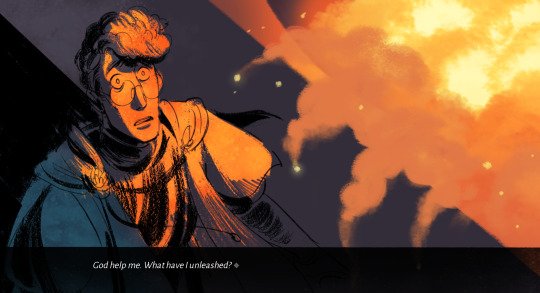
whatever horseshit this confluence of circumstances makes you assume he will pull, i guarantee you it is not the full picture of what actually happens.
24 notes
·
View notes
Text
Bon appétit - Chapter 13: Funnel Cake
[Astarion/Gale]
It's 2 a.m., Gale's tired and wants some food. Astarion, the cute barista/waiter at the Emerald Grove knows how to sate his cravings.
Trigger warning (18+): Alternate Universe - Modern Setting, No Magic, No Vampire, No Wizard, Graphic Description of Sex, Smut, Cum Eating, Blowjob/Fellatio, Frottage, Food Puns, Cheesy Dialog (Pun intended), Waiter Astarion, Professor Gale, Semi-Public Sex, Depraved Carnal Lust
Served to: @patheticfangirl
(I'm sorry for serving plot with the porn, but I can't help myself. I love them too much. >.<)
Athkatla was a bustling metropolis known for its stately temples and royal palace, as well as its beautiful, luscious botanical gardens. Unfortunately, like everything else, Athkatla's beauty had fallen victim to capitalism. Shops with cheaply-made but expensive souvenirs and countless restaurant that sold overpriced 'authentic' Athkatlan cuisine had popped up everywhere like mushrooms in the fall. Now, everything had to be milked and turned into tourists traps. There were a permanent carnival and a Ferris wheel too.
Astarion loathed the place. It was overcrowded, overpriced, and overrated. Still, he couldn’t be too mad about it when he saw how enthusiastic his husband was about all the historical sightseeing. Gale had brought along a honest-to-god hard copy of a guidebook, reading the descriptions of the sightseeing spots aloud to share them with Astarion. It was endearing.
Unfortunately, the couple was forced to cross the carnival to reach the other side of the city. This meant they had to squeeze past honking clowns, pantomimes, and screaming children with candy-covered fingers. Astarion wrinkled his nose and hastily pulled Gale away from the centre of the bustle. He did stop though, to buy some overpriced funnel cake and a candy apple. They leaned against a tree to take a break and hide from the sun.
"Did you know that the carnival’s running non-stop since it was built sixty-five years ago?" babbled Gale.
"No, and I also don't care," retorted Astarion and shovelled some funnel cake into his mouth. Immediately, the taste of oil and sugar was everywhere, and Astarion could barely restrain a gag. His teeth hurt from the too-sweet snack.
"Apparently, the carnival started out much smaller, but grew over time," Gale continued. "People seem to be less interested in the original part because there are no food courts and the booths are a bit run down."
"Fascinating," grumbled Astarion, not at all fascinated by the trivia, and threw the paper plate of uneaten funnel cake into the nearby bin. Then, he tried to bite into the candy apple and almost cracked a tooth. It wandered into the trash can too.
"Let's check it out since it's less crowded."
"Let's not."
"Oh, come on, Astarion. Let's go on an adventure. I'm sure it'll be fun."
"I doubt it," the addressed replied, giving a sniff of disapproval, but nothing could dampen Gale's high spirits. With a beaming smile, he took Astarion's hand and led him towards the original part of the carnival, which was located behind a tree avenue, and named "The Circus of the Last Days".
The guidebook hadn't lied; this part was rather shabby and dilapidated. The wood and canvases of the booths and tents were sun-bleached, and the once vibrant paints were flaking off.
As Astarion and Gale entered the old carnival, a handsome man in his mid-thirties with auburn hair greeted them, smiling brightly.
"Welcome to the Circus of the Last Days! Have fun, and be sure to catch the star of the show, Dribbles the Clown!"
"Ugh! I hate clowns!" groaned Astarion.
Smirking, Gale pulled his husband along to look at the stalls. The first they encountered was a hole-riddled tent with a slanting banner that read "Zara the Mummy". The aforementioned person sat on a rusty chair in front of the tent, shaded by the propped up awning, and wrapped in red fabric strips. It must have been an uncomfortable costume - but maybe it was airy enough to avoid getting a heatstroke. When the 'mummy' spotted them, she threw up her hands in a welcoming gesture and greeted them with an enthusiastic "Mmmh!". Gale waved back. It was silly but adorable. Now, encouraged, Zara jumped up from the squeaky chair and gestured wildly with her hands while making mummy noises.
"Hmhm mmh mmhm?"
"Are you offering to paint our faces?" asked Gale.
"Mhm," nodded Zara.
"Do you have different options?"
"Mhm. Mhmhm. Mmmhm?"
She pointed at a yellowed poster which showed four different kinds of face paint designs.
"Ah, I see," chuckled Gale, seemingly amused. "And how much does it cost?"
"Mh," Zara answered, holding up five fingers.
"Five gp?"
"Mhm."
"Well... alright then. - Astarion, which option do you like best?"
"Excuse me?!" The addressed stared at his husband indignantly. "I won't let a mummy mutilate my perfect face!"
"Hmm!" complained Zara, visibly miffed.
"She's a professional," Gale said. "Let her work her magic."
"Mhm," nodded the 'mummy' happily. Astarion glared at both of them before sighing defeated.
"Fine. I want the "Day of the Dead" motive."
"Mh!" squealed Zara, throwing her arms up excitedly.
"I think the clown makeup would suit you better," teased Gale, and got a withering look in response. Astarion sighed deeply, but sat down on the wobbly chair to let the 'mummy' paint his face. Gale watched, amused, with his arms folded, as the artist carefully applied the paint.
After seven minutes, she was done and handed Astarion a mirror to present her work to him.
"Not bad," praised the blond, pleasantly surprised how well it looked. The area around his eyes was painted pitch-black and the outer lines were adorned with dark red, lace-like loops. With the same red, there was a small flower drawn on his chin. The rest of his face was contoured with more black, and his mouth looked like they had stiches in them, spreading wider than his actual lips, making him look a bit like the Joker.
"Your turn, darling," Astarion said, gesturing towards the chair. Smirking, Gale sat down and chose the skull design.
Another seven minutes later, the brunet sported a white face with yellow teeth, black and grey contour, and black slits along the nose to imitate the hollow, three dimensional nasal cavity.
"You look more beautiful than ever," jibed Astarion and Gale rolled his eyes at him, amused. They paid Zara and explored the rest of the old carnival.
A little person with a top head sold a variety of trinkets at a stall called "Popper's Pop-up Store" and tried to persuade them into buying some 'treatos'.
Lucretious - an elderly drag queen in an elaborated gown, adorned with star and moon sequins that jingled with every movement - extolled a group of artists who were balancing on a rope, spewing fire, and juggling apples.
An odd couple sold 'high-quality marble statues' at their booth called "Stoney and Boney's Bespoke Creations", but one closer look revealed the 'marble' to be cheap plaster that was already crumbling.
A fortune-teller pressed them on reading their palms to see the fate of their relationship. Astarion and Gale waved her off, but she still told them that their bond was 'destined for great pleasures and even greater emotions', whatever that supposed to mean.
At the back corner of the carnival stood a wooden stage where the infamous 'star' of the circus was doing his show. Dribbles the Clown wore a gaudy costume, his pink-blue hair slicked back with too much gel, and the face paint was smudged from sweating under the midday sun. An old, greying Rottweiler was laying at his feet, panting harshly due to the heat.
In a two too-small cages on the right resided a huge, red lizard and a panther. The plaques revealed their names to be Crimson and Shadow-Whiskers. While the lizard lay there apathetically, the panther was walking back and forth nervously. They both looked half-starved and the lack of air conditioners or shade didn't help.
"This borders on animal cruelty," muttered Gale, frowning deeply.
"Buddy the dog is my very best friend. Do you know why?" yelled Dribbles cheerfully. Astarion, Gale, the senior couple next to them, and a father with his child kept quiet.
"Because with him, anything is paw-sible. Wa-hey!" the performer answered his own question, making finger guns. The child frowned, the old man started a coughing fit and his wife patted him on the back.
"Oh good, puns. Because clowns aren't enough of a horror already," Astarion scoffed, clapping sarcastically.
"Hmm. Not to my taste, but I'll take a clown over some hack magician pulling peonies from his breeches," retorted Gale.
"For my next trick, I need a friend to join me on stage. Come on up!" Dribbles cheered. With a shit-eating grin, Gale poked his husband's upper arm and suggested: "You should go up there. You love the spotlight, don't you, sweetheart?"
"What? No. Don't you dare. This isn't funny!" the addressed hissed through clenched teeth, and Gale just had to tease him some more.
"Go on, Astarion. Have some fun."
"Absolutely not! If you force me up there, I'll fucking kill you!"
Laughing gleefully, Gale pulled his sulking husband into a hug and led him away from the stage.
"Who's ready to join me and Buddy?" asked Dribbles, trying to cover up his panic with a cheery tone. "If no one joins us, Buddy will get reeeally sad."
The old man was still coughing and the child started crying hysterically. Their father picked them up with a sigh and hurried towards the green-haired, young woman in a jester outfit who was selling cotton candy.
"You could have gone up there yourself, you know?" groused Astarion, still slightly miffed. Gale snorted.
"I might as well go mount the gallows."
They laughed and made their way over to the cotton candy stall. The child, who'd been wailing mere seconds ago, was now stuffing their face with the sweet treat, making happy noises. Visibly relieved, their father paid the vendor and waddled off with his kid.
"Hi!" greeted the green-haired woman.
"Hello, two cotton candies, please," Gale told her.
"You can choose the colours and flavours, you know?" smiled the vendor.
"Oh! That's new," the brunet blurted out. "I've never done that before."
The woman nodded.
"Yeah, it's our speciality. White is vanilla-flavoured, pink is strawberry, green is apple, orange is, well, orange. And... we have a special flavour you cannot get anywhere else: goodberry!"
"Why on earth would anyone want such a sour taste?" asked Astarion, wrinkling his nose.
"Because it balances out the sweetness and tastes more refreshing," the vendor explained. "It's rather pleasant, trust me."
"I'd like to try all flavours. Is that possible?" asked Gale, and Astarion almost laughed.
"Sure," beamed the woman, "but the cotton candy will be bigger then. It's easier to make it that way. Would you still like two pieces, or would you like to share one huge cotton candy?"
"We'll share," Gale answered quickly.
"Okay."
The young woman filled the first sugar mixture into the machine and switched it on. While spinning the spiderweb-like sugar onto a wooden stick, she sang a cheerful song. Gale recognised it from the classic stage play "Illithid Love: The musical" in which a bounty hunter goes after a monster and falls in love with it. This musical – by none other than Faerûn's most famous author Volothamp Geddarm – had been an instant hit, but caused a bit of a controversy because of the love scene between the bounty hunter and the tentacle monster.
"You have a beautiful voice," Gale told the vendor earnestly. "You should try your luck at performing."
The woman laughed.
"Thank you, and I did, but my dreams were crushed after being repeatedly told that I'm too fat and too ugly to be an actress. So, cotton candy making it is. There are worse jobs than standing around all day until your feet hurt."
Gale frowned, quickly glancing at the woman again before he retorted: "You're neither fat nor ugly, my dear. Don't let other people get in your head and trample your dreams."
The corner of her mouth ticked up.
"Speaking from experience?"
"Unfortunately."
"It wasn't me!" Astarion chimed in hastily, and the vendor snickered.
"I thought so. You two look way too happy to be crushing each other's dreams. - Here you go, gentlemen. That'll be five pg."
"Thanks."
Smiling, Gale handed her the money, and they left with a wave of their hands.
"You're so adorable, darling," giggled Astarion. "'Don't let other people get in your head and trample your dreams'. So cute."
"Shut up," chuckled Gale, ripped off some of the vanilla-flavoured cotton candy, and stuffed it in his husband's mouth. Snickering, the latter let it dissolve on his tongue. Gale tried some of the goodberry flavour, and it tasted lovely. He held some of it out for Astarion who took it immediately. With a hum, the blond closed his mouth around Gale's fingers, sucking off the melted sugar. The brunet's eyes widened and his dick twitched. With a lewd moan, the blond pulled back and licked his lips before opening his mouth and lolling out his tongue. Swallowing thickly, Gale placed some strawberry-flavoured cotton candy on that pink tongue. Astarion closed his eyes as he ate the offering. When he opened them again, they were dark with lust.
"Astarion," Gale said warningly, but felt his self-restraint crumble like a dainty meringue under the slightest pressure of fingertips. His husband stepped closer, right up into Gale's personal space, and the latter almost went cross-eyed to look at him.
"I'd like to try the orange flavour," Astarion purred, parting his lips once more. A bolt of arousal rushed down Gale's spine and he quickly tugged off some of the spun sugar. Feeding it to his husband was a bad idea, because the latter flicked his tongue across Gale's fingers and made a show of swallowing the cotton candy.
"Astarion..." breathed the brunet helplessly. His head was spinning from the heat, the arousal, and the way the blond's soft, wet tongue was sucking at his fingers.
"Feed me something else, love," Astarion whispered. "Something thick and long and hard."
He punctuated the last word by squeezing Gale's half-chub through his Bermuda shorts. The brunet gasped, and the blond use the opportunity to plunge his tongue into his husband's mouth.
"Not - not here," Gale tried to reason.
"Alright. Over there then," Astarion grinned, manhandling his husband behind the animal cages and shoving him against the wood panelling. Gale gasped at the impact and the blond quickly tongue kissed him again. Moaning needily, Gale surrendered, wrapped his arms around Astarion and reciprocated the kiss. The latter grinned victoriously against those soft lips that tasted like cotton candy and cheap face paint. As they parted to breathe, Astarion plucked a tiny piece of flaked-off white makeup from his tongue and flicked it to the side.
"We should stop. We'll get in trouble if someone sees us," Gale tried to reason.
"Exactly. Only if they see us," Astarion countered cheekily, and his husband groaned in defeat.
"Fine, but we must be quick."
"Of course, love."
Astarion dove back in for another kiss while fumbling with the zippers of their shorts and shoving them and their boxer briefs halfway down their asses. With a growl, Astarion could finally take them both in hand and nipped at Gale's lip who moaned lowly in response. Pressed up against the splintering, sun-bleached wood of the animal cages, they traded sloppy kisses, their saliva sticky from the cotton candy, as they were thrusting and humping against each other like horny teens. Wheezing, Gale detached his mouth from Astarion's to gasp: "Close."
Immediately, his husband dropped to his knees and engulfed the brunet's rock-hard length to swallow every last bit of cum. With a lewd slurp, he pulled back, thrusted into his own tight grip three more times before coming onto the dirt between his husband's feet.
"Aaah... fuck..."
With a satisfied sigh, Astarion leaned his forehead against Gale's hipbone. The latter was still panting, his flaccid dick still out in the sweltering heat for the entire world to see. He quickly tucked himself back into his khaki Bermuda shorts. Astarion snickered and looked up at him through heavy, dark lashes.
"What a delicious treat," he purred, grinning. "Thanks for sharing, darling."
Gale couldn't help but blush and chuckle at the absurdity of it all. He handed a tissue to his husband, who quickly cleaned himself off before tossing the soiled paper under the cages. Then, they looked at each other and burst into delighted cackling when they realised the state of their face paints. Due to the heat and their hedonic activity, their sweat had started to leave streaks of white, grey, and black all over their faces and necks. The 'stitches' along Astarion's lips and the red flower on his chin were all smudged, and half of it had transferred onto Gale's face and dick. The latter didn't look any better with the black of his three dimensional nasal cavity and the off-white of the painted on teeth smeared everywhere.
"What a sexy skeleton you are," snickered Astarion and pulled Gale in by the collar for another messy kiss.
"Death looks good on you," Gale jibed before sucking his husband's bottom lip into his mouth, smudging more of the face paint around. As they parted, they were connected by a thick string of cotton candy-flavoured spit.
"I was wrong; we should do this more often," Astarion announced.
"What? Visit a carnival?" asked Gale, mildly confused.
"No, you dork. Painting our faces and fucking in public," retorted his husband, grinning smugly.
Gale couldn't help but laugh at that. He tilted Astarion's head up for another kiss before he took his hand, and they did the walk of shame all the way back to their hotel room. Hair ruffled, face paints ruined.
#baldur's gate 3#bg3#fanfic#astarion x gale#astarion#astarion ancunin#gale#gale dekarios#gale of waterdeep#mind the trigger warning#bloodweave#bon appétit
9 notes
·
View notes
Note
Toby Tobias of the Daily Planet, actually. But I understand the confusion with my lovely coworker, Ms. Raynes.
(My parents thought they were very funny when they named me)
Perhaps an off the record conversation would be agreeable with you? I know a small park on the outskirts of Metropolis that is quite nice this time of year. Perhaps around 5pm? I can bring soup, family recipe.
-Toby 🧡
Well a new name, but one I'm pleased to learn- I've mentioned it's journalists like you that are some of the truest heroes we have?
And the Daily Planet, that's an excellent place to work. You'll know Kent then, lovely man, has small town manners from growing up in Ohio.
I think I'm named after one of my great-great-somethings, so Toby is lovely.
And now you want to bring me all the way out to Metropolis too? Tell you what, let me set you up a flight and a hotel in Gotham. The Botanical Gardens are quiet this time of year. I'll make a business expense of it. You bring the soup, and I'll provide the venue.
7 notes
·
View notes
Text
“The Ones Who Walk Away From The Metropolis"
High in the sky, towering above so far up that not even the clouds could reach the city, a clamoring of bells and celebration echoed far out. This cycle, a Festival was born to the Metropolis. The wind raced through the streets and whipped across a scarlet and ivory dotting of flags. In the alleys between towering housing complexes with skybound roofs and mural painted walls, between old moss-grown gardens and under pipes and mechanical flourish, a cheer was to be heard.
The people were as varied as the sounds of indulgence. Some were decorous, Ancients in long stiff robes of mauve and gray and gilded masks, others grave master workmen with bandaged hands. Some quiet, merry mothers, fathers, and spouses carried their babies and spoke of peaceful delights as they walked. In other streets the music beat faster, a shimmering of gong and tambourine, and drums and howling cheering vocals, and the people went dancing with all manner of feathered outfits and scale endowed drapery. Children dodged in and out, their high calls and squeals raised higher, and higher. Far above the clouds, hollering joy over the music and the singing.
A marvelous smell of cooking wafts from between steam vents and stone buttresses and rebar gaffs. The faces of small children are amiably sticky from sweets and dotted on the corners of an elder's maw, a smattering of crumbs of rich pastry are plastered. An old woman, small, fat, and laughing, is passing out an assortment of beautiful botanical trimmings from her satchel, and the passersby young men wear her flowers on their robes or within braids of feathers or poked through ornate detailings of their masks. A child of nine or ten sits at the edge of the crowd alone, giving breath to a humming instrument, eyes shut tight as he loses sense of the world within his devotion to the instrumental flourish.
But there is one more thing, hidden in plain sight of the city.
In a basement of sorts under a faraway isolated branch of the Superstructure, connected via an access shaft to a tiled interior, there is a room. The only way to the surface is through the maintenance shaft, the other exit only leads deeper down into the labyrinthine mechanical entrails of the entity. There are no windows. No light seeps in except for what is created by a million processors all firing at once on every circuit, crunching numbers away solving an evermore insolvable problem. In one corner of the little room an articulated limb winds and contracts, its surface more bone than metal, swivels near a wired chord encased in a densely packed lipid membrane. The floor is metal tile, dry as bone despite the rivers of water coursing through the superstructure at all times.
The room is approximately twenty five to fifty paces in all dimensions (depending on whose stride for measurement is used), and despite its size, it is completely barren save for whatever projections line the walls at a given moment. In the room, the child is sitting. He is the child of the city - he is the city. His interactive body is an artificial construct appearing no taller than a child of 6, though he bears more mind and memories than the collective overhead populous. It winds from corner to corner without acknowledgement of his own density inside the weightless chamber, idly twisting and turning as its only thoughts are of a great problem to be solved. Hovering before him are sets of pearls and marbles, filled in with as much working information he can store as his conscious mind is forever burdened with as much memory usage his systems can take. The door to his maintenance shaft is always locked; and nobody ever comes, except that sometimes - the mechanical child of the people has no understanding of time or interval, only the terrible omniscience of the ongoing cycle - sometimes his maintenance panel door rattles terribly and opens, and a person, or several people, are there. Some forcefully tear him away from his work, bothering him with incessant questions about politics and leadership, with his answers being routinely ignored. Others maintain his water intake and demand quotas for food and nectar production, always wanting more for less, and he complies as the taboo against disobedience is often too great to ignore. Others still never come close, but peer in at it with frightened, disgusted eyes, as he is once again reminded that to many he is an affront to divine sensibilities. As soon as they come, the door is locked and their masked faces disappear.
The child of the city has always lived in the tiled room, but he remembers sunlight and a mother's voice through the memories donated to his data storage. He can see the outside through his hundreds of eyes made to monitor the safety of his people - his parents. He is frustrated, yet knows better than to beg to be let out and enjoy the city. They couldn't even if they wanted, it's not his purpose. When he first awoke, he would often cry through fits of desperate rage, screaming a good deal as he tried to overcome his obedience protocols. Most of the other gods in his position did so when they were young anyhow. While he still bears rage and frustration, he knows better than to weep and he speaks far less often, but during more desperate times a soft quiet murmur of despair will faintly echo through the superstructure.
They all know it is there, all the people of the Metropolis.
Some of them have come to see it, others are content merely to know it is there. They all know that it has to be there. Some of them understand why, and some do not, but they all understand that their happiness, the beauty of their city, the tenderness of their friendships, the health of their children, the wisdom of their scholars, the skill of their makers, even the abundance of their harvest and the kindly weathers of their skies, depend wholly on this child's abominable misery.
This is known by every resident of the city. There is special recognition bestowed upon the architects and the engineers and the constructors for his being. It is explained that he is a gift, one for them and for everything living in the world. This god that they have made will see to the end of the cycles every last creature is burdened with, all they have to do is lay and wait for his great solution to their great problem. They send him sacred ash and their understanding of the world, all to further his work. They paint murals on his body, they heal his wounds, they sing ritual chanting above and within him, and they keep him at work. There are some who would like to do something for his freedom, but there is nothing to be done. If he were let out into the miracle of the sky and sun, if he could shirk his duties as a path to salvation and walk among the people instead, that would be a good thing, indeed. However, if it were done, as they see it, all the prosperity of the Metropolis and the promise of freedom to all people and creatures would wither and be destroyed. Those are the terms. To exchange all the goodness and grace and promise of relief from the cycles of burden of every life in the whole world for that single, small improvement: to throw away the promise of ascension and release of the troubles and pain of the world of millions for the chance of happiness of one: that would be an unthinkable devastating damnation.
Most don't even consider the option, for there is nothing more burdensome than the cycles upon every man and beast, there is nothing that could ever rival the chance to stop the ongoing birth and death of every peoples. This purposed organism is a reasonable sacrifice if it means the prosperity of the people above and the eventual freedom in release. There are a few who may brood over this terrible paradox for cycle after cycle. But as the days linger on, they begin to realize that even if this child of the people could be released from his duty, it would not get much good of its freedom: a little vague pleasure of warmth and food if it could even feel such perhaps, but little more. Nothing it hasn't already had the chance to experience through the multiplicity of memories so lovingly gifted to it. It is too burdened by its hard coded taboos to know any real joy. It has been frustrated and miserable too long ever to be free of grudge. Its habits are too alien and tiresome for it to respond to humane treatment. Indeed, after so long it would probably be harrowed and frightful without walls about it to protect it, and darkness for its eyes, and piles and piles of data to mull over.
And yet, there is one more incredible thing to tell.
Some children when brought to tears or rage do not go home to cry, they do not go home at all. Sometimes one much older falls silent for a cycle or two, then leaves home. These people go out from the city, and walk down the street alone. They keep walking, past the rickety steam powered gates, and walk straight out of the Metropolis, down the sparsely used elevator shafts through the legs of the superstructure. They keep walking, headed ever west past the scraping chimney stacks, past the odd specters of concrete in the sunset graced sky, past the flourish of the farm arrays. Each one goes alone, child, man, woman, or otherwise. The end of the cycle rears once again with the dreadful thundering announcement of an oncoming storm. The travelers all pass down into a deep wound of the earth, deeper into the depths, past vast heaps of industrial mining equipment and through decayed village streets, between the stone temples and the looming beings within. Each alone, they go ever west, down into that gullet of a canyon. They walk and crawl and creep ahead into the deepening darkness, and they do not come back.
The place they go towards is a place even less imaginable to most of us than the city of happiness. I cannot describe it at all. It is possible that it does not exist. But they seem to know where they are going, the ones who walk away from the Metropolis.
#the ones who walk away from omelas#rain world#five pebbles#writing#rain world spoilers#rw spoilers#spoilers#rw five pebbles#five pebbles rw#rw ancients#ancients#ancients rw#fanfiction#short fiction#text#my art#my writing#my stuff
12 notes
·
View notes
Text
A bit about me
Hello! Hi! You can call me Gothic (the character/oc that runs this blog), if you would like, I'm not too keen about sharing my name yet. Gotham is a big city, but I'm pretty easy to spot in a crowd.
My meta gene activated when I was really young, to the point where I don't even remember why or how, but it effects the way I look more-so than giving me noticeable powers that some other metas have.
My friends joke that people, animals and plants just seem... healthier around me, but I do not think it is related.
My mum says that the mutation I have may be genetically tied - as one of my relatives had traits that were similar. What this exactly means - I have little idea. Doctors have been no help in the matter.
I am often able to cover the mutations with hats and other clothing, but shoes have been difficult to manage. I have yet to find a pair I can appropriately modify.
Thankfully this has allowed me to fly under the radar for rogues thus-far, but I worry.
I was raised in Central City, where my family still lives, but I moved to Gotham to attend school. I currently live in the student housing, but have plans to move into an apartment closer to the botanical gardens once spring hits.
My personal favorite heroes are the Flash and Wonder Woman.
Favorite vigilante is Spoiler. She's amazing.
Some other notable people you may see on my blog!:
Toby -- My lab partner in the Botany lab, and overall a good guy. He knows about the blog, and occasionally posts on my behalf. He is a TA for a biology lecture.
My mum -- has supported me from day one in pursuing my degree. She is my go-to person for information, and helped me find scholarships for different universities.
My aunt Kay -- "Kay" is short for... something. She has never told me what it is short for. She works as a musician.
Dustin -- My friend from childhood who is attending school in Metropolis.
----------------------
Now! About the person behind the blog! Hi there! You can call me Beck. I'm a fairly casual fan of all things DC, and am working on familiarizing myself with more the fandom as a whole. Most of my DC knowledge is centered around film/animation/info from friends, and as such I am not in the know about everything in the comics. I know some of the MAJOR events, but not everything. I apologize in advance if anything I post doesn't fit the canon, but this blog is mostly to have fun and get my creative writing fixations out into the world. Feel free to interact with Gothic as much as you would like! I love seeing people enjoy my writing and expand upon it.
If you have any questions, send them in, and I will answer them to the best of my ability!
21 notes
·
View notes
Text

today's preview is a more introspective look at the larger of our two locations - remington, georgia. while it has the glitz and glamour that sable grove could never aspire to, there are some who can't stand the hustle and bustle of someplace that always seems to be in motion. take a peek under the cut for it's full history alongside the six neighborhoods waiting within. if you have any questions, you know where to find us!
✨ explore remington, ga ✨
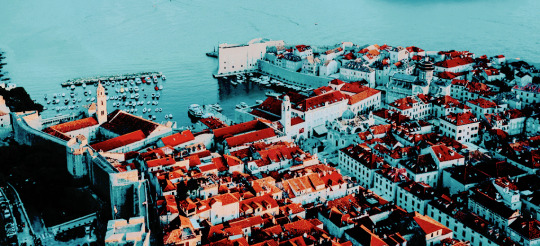
the city of remington was founded in late 1829 during the georgia gold rush. it was a larger settlement for the prospectors that used to travel to sable grove to strike it rich. today, it is a thriving metropolis home to such prominent tourist attractions such as the great rapids amusement park, the barlowe botanical gardens, and distillery drive. it is also home to remington university and the official home of nfl team the remington prospectors, nhl team the remington gold hawks, and the mlb team the remington 29ers. remington is also known to be a festival city during the summers, hosting events such as the taste of remington and the street buskers festival. to the world, remington seems like a city of promise, however, if you look a little closer you’ll see dilapidated buildings with graffiti protesting the oppressive hold of corporations, you’ll see broken swing sets in seedy neighborhoods, and you might just be able to see deals being made on street corners. remington proves that even the shiniest of exteriors can have the grimiest of secrets lurking within.
barlowe reef
population - 20660 | price point - $$$ to $$$$
home to the barlowe botanical gardens and the great rapids amusement park, the neighborhood of barlowe is known as a tourist haven. the northernmost peak of remington, you’ll also have access to the barlowe bridge which connects remington and sable grove across bennington bay. it also houses the shorefront which showcases the pier and harbor. housing in the area is middle tier and largely populated with airbnbs and hotels.
camden
population - 17486 | price point - $$$ to $$$$$
camden is a historic part of remington that was once lined with bootleggers and secret speakeasies between the 1920s to the 1930s. now, it is widely known as the fine arts and cultural district. it is home to the remington art gallery and theatre alley which is home to the remington ballet company, the remington philharmonic, and the remington players. it is also home to jazz clubs, piano bars, and of course your good ol’ country music bars. some casting agencies, modeling agencies, and production companies also call camden home. the neighborhood also has a series of small man-made parks and trails that are a runner’s paradise. this area houses a lot of trendy apartment buildings, brownstones, and houses with old world charm that tend to be perfect for those in the middle-income or higher income brackets.
crestmont
population - 10576 | price point - $$$$ to $$$$$
crestmont is remington’s financial and governmental neighborhood. you’ll find city hall which houses city council offices, the mayor’s office, and all the major courthouses. it is also home to the remington police department and the sheriff's station. crestmont also has easy access to remington memorial hospital and the remington firehouse. around the corner from city hall is market street which is home to well known financial institutions, major real estate developers, and also larger tech and entertainment-focused companies. homes in this area are relatively pretty expensive and swanky and feature penthouses, brownstones, and luxury apartments.
cromwell
population - 14177 | price point - $$$ to $$$$$
cromwell is perhaps one of the busiest neighborhoods in remington featuring all the major sports arenas and stadiums as well as the larger concert venues. it is home to palladium square which is full to the brim with street performers and buskers. during the weekends, there is a large farmer’s market and craft and book fairs. it is also a hop skip and jump from remington public library and cromwell park. due to its resemblance to many popular cities, cromwell is a popular filming location. you’ll find mid-tier to high-tier housing in the area, and it is home to many families with young children.
snakeleaf
population - 20101 | price point - $ to $$$
back in the 1800s, the snakeleaf area used to be swampy marshy lands where only the underlings of the city used to congregate. it still maintains its “seedy” reputation with its collection of motels and other shady businesses. unlike the rest of the city, the snakeleaf area is not prim and pristine. however, some would argue that this is where the real deals in the city happen and not in crestmont or cromwell. the main highlight of this area is the abandoned shoe factory which is a popular venue for raves, outlandish parties, and general debauchery that is rented by more elite hands than you would think to imagine. housing is cheap here, but it comes at the cost of your safety and sanity, quite frankly.
yearwood
population - 30000 | price point - $ to $$$
yearwood widely known as the education district, yearwood is home to remington university spanning ten whole city blocks. around the corner from remington university, you’ll also find the yearwood mall and tucked in a corner is distillery drive which features bars, clubs, taverns, cafes, and restaurants that are popular with students, remington residents, and tourists alike. at the end of distillery drive, you’ll find the wall, a skate park with a massive brick wall that is frequently tagged with graffiti, murals, and messages. housing in this area is relatively cheap and largely occupied by students or early career professionals.
8 notes
·
View notes
Text
Montreal is a city animated by a lingering cosmopolitan phantasmagoria, especially its two ‘man-made’ islands, Île Sainte-Hélène and Île Notre-Dame. Built to host Expo 67, a colossal World’s fair resting on dredged soil and urban debris, they became the experimental landscape and socio-technical matrix of the future megacity Montreal dreamt of being. This event crystallized the city’s image as the avant-garde “capital of the megastructure,” a concept which redefined (urban) spaces as dynamic relationships between people, technology, and dwellings, “coded [...] by notions of process” akin to those of the organism (Riar 2020, 200). Thirteen years later, the Floralies Internationales de Montreal was held in the wake of “Man and his World,” the fair’s permanent exhibition on Île Notre-Dame. The 8th International Horticultural Exhibition invited citizens to admire “the world’s most beautiful botanical garden” representing the cultures of twelve nations, including Canada. [...] The organizers viewed the gardens as “soft technologies,” designed to beautify the city while benefiting its economic and cultural sectors. [...]
[Gardens] offer “profound insights [...].” They are “sites where people explicitly stage [...] their relationships with nature” [...]. Gardens not only inform what [...] dwellers find valuable and good, they organize the political and economic relations urban centers cultivate - or not - with their peripheral others -- rural lands, ‘nonhuman’ life and ‘nonlife’. Botanical gardens, such as the Floralies [...] are not merely displays of state power and scientific knowledge, but technologies [...] that operate by transplanting alien ecological - so-called rural - habitats into the hybrid spaces of a metropolis.
And while we could frame this dynamic within urban/rural or center/periphery binaries, I contend that what made the Canadian garden a garden in 1980 was precisely its relationship to what lies far beyond the theoretical scope of such binaries - that which eludes rigid biological and geographical inscriptions: wetlands. What follows is a meditation about murky and precarious dwellings. And about binaries, and the relentless oscillations that govern places of belonging. It is an invitation to consider urban and rural geographies and all that lies beneath and beyond their preference for the living.
And it is the story of a northern peat bog that was “transplanted” to Île Notre-Dame in 1979.
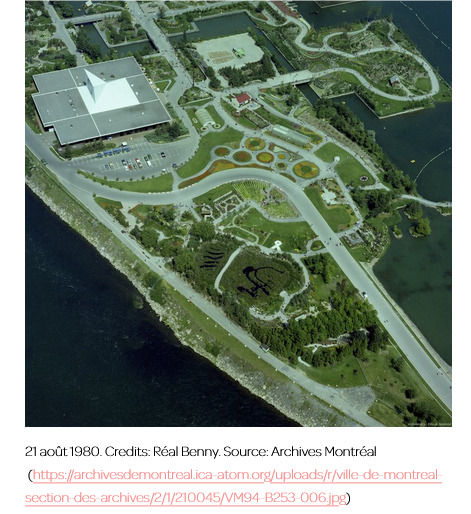
“A little bit of James Bay in Montreal”
It took a fleet of trucks fifty 36-hour trips to haul half an acre of James Bay to Montreal. That “little bit” of Northern Quebec was more precisely 1300 frozen blocks of peat taken from the Hélène Lake bog, near the construction site of the LG2 hydroelectric project. [...] The blocks [...] were then reassembled [in Montreal] [...]. To ensure that the Notre-Dame peat bog bloomed in time for the Floralies, a year later, gardeners carefully monitored water and acidity levels [...]. The garden's “spongy consistency,” created by a combination of sphagnum mosses, tamarack, black spruce, hairy honeysuckle, round-leaved sundew, and Labrador tea, amongst 50 northern species, could be admired for the first time in Montreal’s temperate climate, a stark contrast to the hydrogeoclimatic conditions of James bay, 1500 km away [...]. In 1980, thirteen years after Expo 67, the bog was fully integrated as yet another dynamic process in the city’s “organic” megastructure.
Why did the chief horticulturist of the Montreal Botanical Garden choose to represent the “nation” with a northern peat bog?
Because Canada was, and still is, home to a quarter of the world's wetlands, which had already been massively drained for agriculture and urban sprawl. The garden's purpose was to bring the ecological benefits of these threatened ecosystems to an emerging environmental awareness.
Montreal, which used to be completely surrounded by “swamps and boggy places” [...] considered unsanitary in the 19th century, destroyed much of the riparian wetlands in the St. Lawrence Lowlands, eliminating 80% of its marshes [...]. The stinging irony is that manufacturing the islands for Expo 67 “was one of the single most damaging projects” for the surrounding wetlands (ibid.). So how could they be celebrated as part of a national heritage? [...]
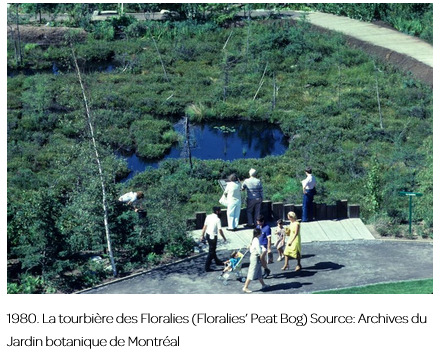
“Canada is the wetlands settler country par excellence” (Giblett 2014, 11), as, much like Montreal, most of its early settlements were built alongside marshes. Its colonial literature has long portrayed these places as murky, monstrous, and ominous.
In the dominant cultural paradigm, marshes were seen as wastelands, which licensed industries to dump toxic waste in their waters or to drain them (35). Seen as dead and inauspicious lands, swamps, marshes, and bogs posed a threat to colonial powers, while being particularly difficult to map, as water and land were inextricably linked. Peat bogs especially are dense and viscous worlds where mosses thrive on top of their own decaying shroud, a process reaching back into the Carboniferous era “when swamps ruled the earth” (203).
---
This story of a garden made of moss not only reveals how Montreal discredited the way the Cree community valued and used wetlands, but offers insight into the colonial governance of Canada and Quebec. [...]
Ultimately, representing peat bogs as “barren lands” speaks to the political figuration of all that is not urban, or, in Giorgio Agamben’s words, as bare life, which, in Western politics, “has the peculiar privilege of being that whose exclusion founds the city of men,” ordered by the “good life” (Agamben 1998, 7). To be preserved, the elusive and ominous peat bog had to be transplanted to the city, where it could be a tamed vehicle [...].
Rethinking geographies beyond anthropocentric [...] views of what defines urbanities and ruralities, might allow us to better understand the constitutive exclusions that created this binary in the first place. In Canada, both urban centers and rural regions have been constituted through the destruction of wetlands. This was repeated in the 1980s, when, just two years after the Floralies championed the city’s green turn, the Notre-Dame peat bog was abandoned. Today, if you were to go there, you would find a dried-out pond, where meridional species have reclaimed their rights.
But perhaps its disappearance from the city's landscape is a sign that wetlands remain unsettled and unsettling.
---
Text by: Isabelle Boucher. “Urban Mires: What Happened to the Garden of Moss?” Heliotrope, Environmental Media Lab at the University of Calgary. 19 April 2023. [Bold emphasis and some paragraph breaks/contractions added by me. Images and captions are shown as published with Boucher’s text in the same article.]
50 notes
·
View notes
Text
Exploring the Botanical Holiday Train Show at the New York Botanical Garden
Exploring a Unique Botanical Wonderland in New York City Good morning! It’s Monday, and today we invite you to embark on a captivating journey through a city within the city—one that is ingeniously crafted from acorns, tree bark, and an array of other natural materials. We will also delve into the recent inquiry by the State Department of Labor concerning Shen Yun Performing Arts. This New York…
#acorns#botanical metropolis#freight trains#holiday train show#iconic buildings#Jennifer Bernstein#miniature New York City#natural materials#New York Botanical Garden#Shen Yun Performing Arts
0 notes
Text








Metropolis was founded in 1634 by Dutch settlers, prospering in trade for its natural coastal harbor. The first settlement was by Dutchman Paul De Vries being called De Vires Village now known as the Old City in Queensland Park. In 1783, the first Metropolitan Bank was opened by P Randall Jeffries, that which still exists today. The mid-1800s saw the Hob's Bay area of the city grow as a merchant center. The large influx of Irish immigrants during this time rose tensions with the second generation citizens of Metropolis, leading to the well-known Hob's Bay Riots. Metropolis would prosper during the Industrial Revolution with the founding of The Steel Works. Today, Metropolis is known as the City of Tomorrow, a nickname adopted from our innovation and our hopes for the future.
WELCOME TO THE CITY OF TOMORROW [ x ] Brought to you by the City of Metropolis Historical Society
NOTABLE PLACES OF INTEREST : Bach Square , Blaze Comics , Centennial Hotel , Daily Planet Building , Daily Star Building , Danko Field , Delaware Bay Pier , Emperor BLDG , Famous Bottle Works , First Metropolis Bank , Glenmorgan Square , Halldorf Hotel , Heroes Park , Hotel Anderson , Javins Park , Lacy's Department Store , LordTech Tower , LordTech Stadium , LuthorCorp Plaza , LuthorCorp Tower , Mason Oil BLDG , Metro Bank , Metropolis Botanical Gardens , Metropolis City Hall , Metropolis History Museum , Metropolis Municipal Pier , Metropolis Museum of Art , Metro Stock Exchange , Metro Palace Theater , Metro Tower , Metropolis University , Prince Tower , Southside Park , Superior County Court , Toth Square , Turley Gallery and Wayne Financial Tower .
5 notes
·
View notes
Text
London: The Heartbeat of England
London, the pulsating heart of England, stands as a testament to the confluence of history, culture, and modernity. From its iconic landmarks to its diverse population, this vibrant metropolis has captivated the world for centuries.
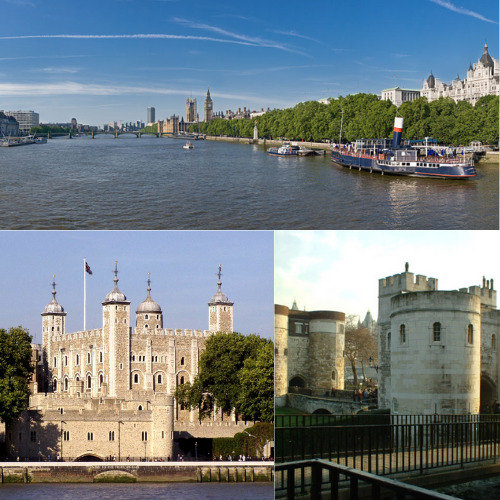
A Tapestry of History
Stepping into London feels like embarking on a journey through time. The city's streets whisper tales of monarchs and revolutionaries, poets and playwrights. Towering above the River Thames, the Tower of London stands as a stoic guardian, its walls echoing with stories of intrigue and betrayal. Across the river, the majestic dome of St. Paul's Cathedral pierces the skyline, a symbol of resilience and endurance through centuries of change.
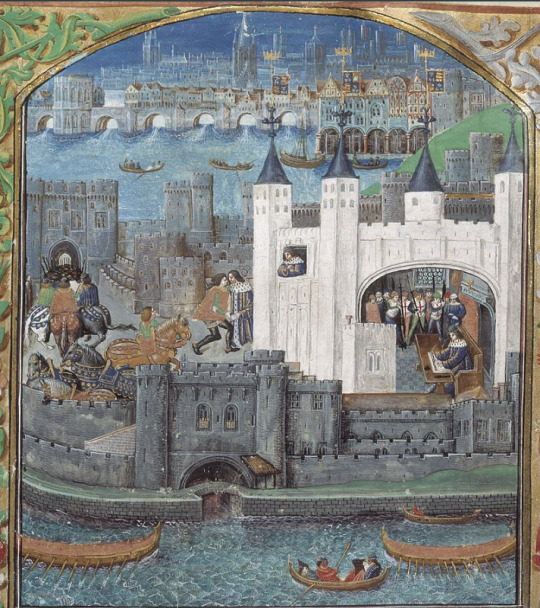
Cultural Melting Pot
London's allure lies not only in its history but also in its cosmopolitan atmosphere. Wander through the bustling streets of Soho, where every corner reveals a new culinary delight or artistic masterpiece. Lose yourself in the vibrant colors of Camden Market, where diverse cultures converge to create a tapestry of tastes, sounds, and experiences.

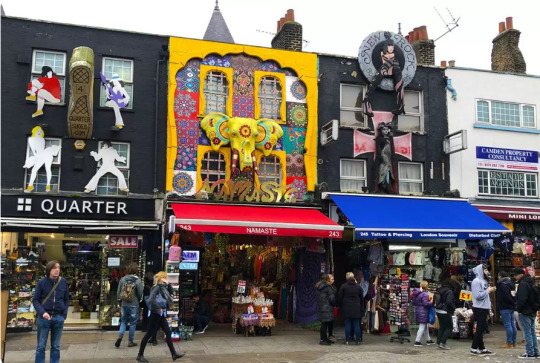
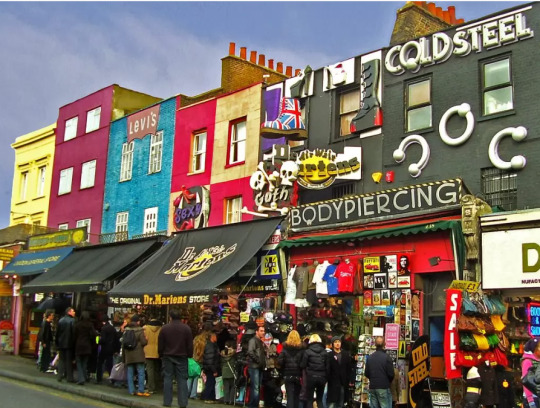

Iconic Landmarks
No visit to London is complete without paying homage to its iconic landmarks. From the timeless elegance of Buckingham Palace to the modern architectural marvel of the Shard, each structure tells a story of London's past, present, and future. Take a ride on the London Eye for a bird's-eye view of the cityscape or stroll along the banks of the Thames, where the past and present merge in perfect harmony.


Green Oasis
Despite its bustling streets and towering skyscrapers, London is also a city of greenery and serenity. Hyde Park, with its sprawling lawns and tranquil lakes, offers a peaceful retreat from the urban hustle and bustle. Meanwhile, the enchanting beauty of Kew Gardens transports visitors to a botanical paradise, where exotic blooms and ancient trees create a sense of wonder and awe.
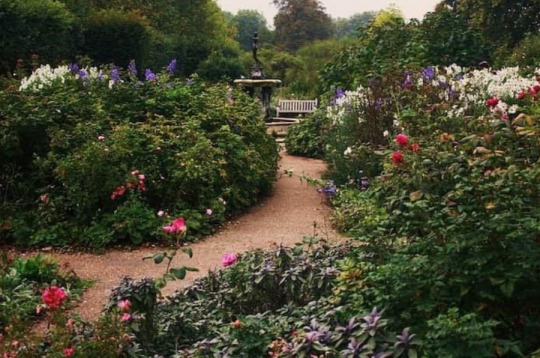

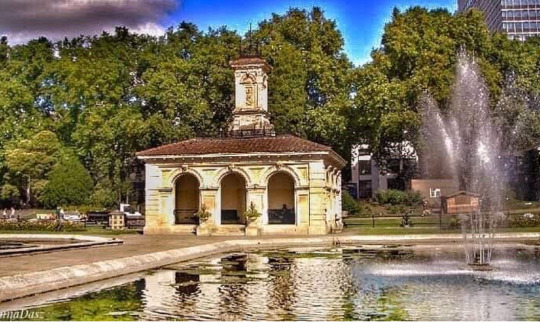
The Spirit of London
Above all, London is defined by its spirit – a spirit of resilience, creativity, and inclusivity. It's a city where tradition and innovation coexist, where old-world charm meets cutting-edge technology. Whether you're sipping tea in a quaint café or exploring the latest trends in fashion and design, London never fails to inspire and enchant.
In conclusion, London is more than just a city; it's a living, breathing entity – a vibrant tapestry woven from the threads of history, culture, and diversity. So, whether you're a first-time visitor or a seasoned traveler, immerse yourself in the magic of London and discover why it truly is the heartbeat of England.
2 notes
·
View notes
Text

Hair and Beauty Salon Secrets Revealed: Insider Tips for Gorgeous Locks and Flawless Skin
Unlocking Dubai's Beauty Trends: What's Hot in Hair and Skincare
Welcome to the vibrant world of beauty salon in Dubai, where innovation meets tradition, and luxury intertwines with culture. In this bustling metropolis known for its skyscrapers and desert landscapes, beauty is not just a concept but a way of life. From the latest hair and skincare trends to innovative treatments and personalized rituals, Dubai's beauty scene offers a tapestry of experiences that cater to every individual's unique style and preferences.
Hair Artistry: Customized Color Blends
Dubai's Hair and beauty salon are renowned for their artistry in creating customized color blends that enhance natural beauty. Embrace the trend of "root smudging" for a seamless transition between hair colors, minimizing harsh lines and creating a softer, more natural look. Ask your stylist about incorporating subtle highlights or lowlights to add dimension and depth to your hair color, achieving a personalized and stunning result.
Hair Care Routines: Nourish and Shine
To achieve luscious locks, start with a nourishing hair care routine. Use sulfate-free shampoos to retain moisture and follow up with a hydrating conditioner. Opt for regular hair spa treatments to strengthen your strands and prevent breakage. Ask your stylist about custom hair masks for an extra boost of hydration tailored to your hair type.
Skincare Regimes: Glow from Within
Living in Dubai's desert climate requires special attention to hydration in skincare, especially when indulging in the best facial in Dubai. Due to the arid environment, your skin may need extra nourishment to stay healthy and vibrant.
One effective strategy is to opt for skincare products enriched with desert botanicals like prickly pear oil or camel milk. These ingredients are renowned for their moisturizing and nourishing properties, providing your skin with the hydration it craves in a dry climate. Incorporating such products into your skincare routine can complement the benefits of your facial treatment, leaving your skin feeling refreshed and revitalized.
DIY Maintenance: Pamper at Home
Between salon visits, pamper yourself with DIY treatments for hair and skin. Create a nourishing hair mask using coconut oil, honey, and avocado to restore shine and softness. For glowing skin, try a homemade exfoliating scrub with sugar and olive oil to slough off dead cells and reveal a fresh complexion.
The Art of Hair Colouring: Trends and Tips
When it comes to hair color, Dubai's salons offer a spectrum of options to express your style. From balayage to bold hues, consult with a color specialist to find the perfect shade for your skin tone. Opt for ammonia-free dyes for a gentle yet vibrant color that lasts longer without damaging your hair.
Skincare Innovations: Science Meets Beauty
Dubai's best facial treatments combine science and luxury to transform your skin. Explore treatments like microdermabrasion, which uses tiny crystals to exfoliate and rejuvenate the skin's surface. For acne-prone skin, consider LED light therapy to reduce inflammation and promote healing. Hydration-focused facials with hyaluronic acid are perfect for plumping and hydrating dry or aging skin.
While focusing on hair beauty, don't forget the importance of scalp health. Dubai's salons offer innovative scalp treatments that promote healthy hair growth and scalp balance. Treat yourself to a scalp detox treatment to remove build-up and revitalize your scalp, followed by a soothing scalp massage using essential oils like tea tree or peppermint for a refreshing and invigorating experience.
Choosing the Right Facial: Tailored to Your Needs
Finding the best facial treatment in Dubai starts with understanding your skin concerns. For acne-prone skin, look for facials with salicylic acid or glycolic acid to unclog pores and prevent breakouts. Anti-aging facials often include ingredients like retinol and peptides to stimulate collagen production and reduce fine lines. Hydrating facials with hyaluronic acid and antioxidants are ideal for dry or dehydrated skin, restoring moisture and radiance.
With these insider tips and trends, you're equipped to embrace Dubai's beauty scene with confidence. From nourishing hair care routines to science-backed facial treatments, prioritize self-care and indulge in the transformative power of beauty rituals. Whether at the salon or at home, let your beauty shine inside and out.
#BeautySalonDubai#BestFacialDubai#HairAndBeautySalon#BestFacialTreatmentDubai#FacialTreatments#GlowingSkin#DesertBotanicals#SkincareRoutine#HealthySkin#FacialRefresh#DubaiSpa#SkinCareTips#BeautyInDubai#SkinCareRegimen#PricklyPearOil#CamelMilkSkincare
2 notes
·
View notes
Text
Top 20 Most Beautiful Cities In Africa | Travel Tips
Certainly! Africa is a continent known for its diverse landscapes, rich cultures, and vibrant cities.
You may choose to watch Top 10 Most Beautiful Cities In Africa | Best Places
youtube
Here's a list of 20 of the most beautiful cities in Africa, each offering its own unique charm and appeal:
Cape Town, South Africa: Nestled between the iconic Table Mountain and the Atlantic Ocean, Cape Town boasts stunning natural scenery, vibrant neighborhoods, and a rich cultural heritage.
Marrakech, Morocco: Marrakech mesmerizes visitors with its bustling souks, intricate architecture, and the vibrant colors of the Jardin Majorelle.
Nairobi, Kenya: As the gateway to East Africa, Nairobi blends modernity with wildlife conservation, offering attractions like Nairobi National Park and the Karen Blixen Museum.
Fes, Morocco: Fes is a UNESCO World Heritage Site renowned for its medieval medina, elaborate mosques, and labyrinthine alleyways.
Cairo, Egypt: Cairo is a bustling metropolis steeped in history, home to ancient wonders like the Pyramids of Giza and the Sphinx, as well as vibrant markets and lively streets.
Zanzibar City, Tanzania: The old Stone Town of Zanzibar City is a UNESCO World Heritage Site, featuring ornate doors, winding alleys, and beautiful beaches.
Luanda, Angola: Luanda is a coastal city with a mix of Portuguese colonial architecture and modern skyscrapers, offering stunning seaside views and a vibrant nightlife.
Johannesburg, South Africa: Johannesburg is a dynamic city known for its cultural diversity, thriving arts scene, and historical sites like the Apartheid Museum.
Dakar, Senegal: Dakar is a lively coastal city with colorful markets, vibrant music scene, and stunning beaches like Yoff Beach and N'Gor Beach.
Cape Coast, Ghana: Cape Coast is known for its picturesque beaches, colonial architecture, and its historic role in the transatlantic slave trade, evidenced by landmarks like Cape Coast Castle.
Asmara, Eritrea: Asmara boasts a unique blend of Italian colonial architecture, modernist buildings, and palm-lined boulevards, earning it recognition as a UNESCO World Heritage Site.
Windhoek, Namibia: Windhoek is a city surrounded by breathtaking landscapes, offering visitors a blend of German colonial architecture, lively markets, and nearby safari adventures.
Kigali, Rwanda: Kigali is a clean and green city known for its orderly streets, cultural attractions like the Kigali Genocide Memorial, and stunning views of the surrounding hills.
Accra, Ghana: Accra is a vibrant capital city with lively markets, beautiful beaches, and historical landmarks like Independence Arch and Jamestown.
Lagos, Nigeria: Lagos is a bustling megacity with a vibrant atmosphere, offering a mix of beaches, bustling markets, and a thriving arts and music scene.
Addis Ababa, Ethiopia: Addis Ababa is a city of contrasts, blending modern skyscrapers with traditional Ethiopian architecture, vibrant markets, and cultural attractions like the National Museum.
Maputo, Mozambique: Maputo is a coastal gem with a laid-back atmosphere, colonial-era architecture, vibrant markets, and stunning ocean views along its scenic waterfront.
Stone Town, Zanzibar: Stone Town is the historic heart of Zanzibar, known for its narrow streets, ornate doors, and rich Swahili culture, offering a glimpse into the island's past.
Gaborone, Botswana: Gaborone is a modern city surrounded by natural beauty, offering visitors botanical gardens, wildlife reserves, and a thriving arts and crafts scene.
Abuja, Nigeria: Abuja is Nigeria's modern capital city, known for its impressive architecture, lush greenery, and cultural landmarks like the Nigerian National Mosque and Aso Rock.
Read more
Top 15 Best Places To Visit Tokyo Japan | Tourists Attraction
Top 10 Best Places To Live In UK [ United Kingdom] 2024
Top 10 Best Places To Live In Canada 2024 | Best Cities
Top 10 Best Places to Live in America [ USA Cities ] 2024
How To Make Money : Top 10 Niches To Monetize YouTube
Hillbrow Johannesburg The Vibrant Area Of South Africa
Dubai Downtown Walking Tour 2023 | Burj Khalifa UAE
Dubai Beach: Walking Around | The Best Tour 2023
Ethiopian Airlines Flying Queue At Addis Ababa Airport
3 notes
·
View notes